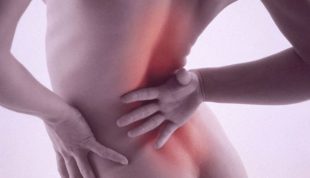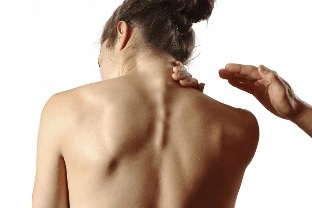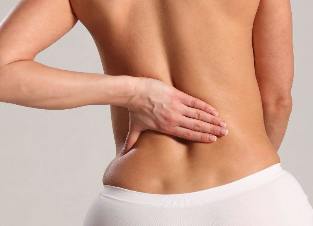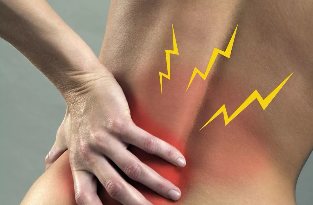
Back pain is one of the most common complaints among people. Unlike all other mammals, only people experiencing back problems, because to go directly significantly increases the load on the spine.
The spine consists of several departments, and often throbbing pain in the back is localized only in one of them.
Causes discomfort
Factors affecting the deterioration of the spine known to all:
- sedentary a sedentary lifestyle;
- lack of exercise;
- sudden weight lifting;
- heavy physical labor.
In addition, the influence of genetic factors and comorbidities, which, for example, impair blood circulation in the spine.
The spine is a group of vertebrae, between which there are elastic disks, which play the role of shock absorber. The mobility of all segments attach to the facet joints and articular cartilage.
Violation of the integrity or location of any part of the vertebra leads to various pathologies, and expressed pain.

From the spinal cord out the particular nerve roots that pass close to the vertebrae, so most of the discomfort associated with their infringement.
Mostly throbbing pain in the spine occurs for the following reasons:
- Cracks in the vertebrae.
- Low back pain.
- Spondylosis.
- Hernia between vertebrae.
- Lumbago.
Such a serious disease are easily distinguished from ordinary back pain because in the latter case it is only the inflammation or the stretching of the muscles, and the condition passes quickly. In the case of lesions of the spine the sensations are extremely powerful and require a serious treatment measures.
Cracks in the spine
In fact, in the medical community the term is not adopted. The term "crack" means rather incomplete fracture without spinal cord injury.
The spine is designed to support the whole body, while it is quite flexible and agile, resulting in possible to make various turns, tilts. However, even such nearly perfect mechanism is extremely unstable.
Cracks can occur for the following reasons:
- Bad fall or performing sports exercises.
- Falling from a great height.
- A sharp compression of the body (such as a car accident).

Older people represent a special risk group because they have such damage can occur even with minimal strain on the back, their vertebrae are too fragile and not sufficiently supplied with necessary microelements.
Not always people can immediately suspect in itself a violation of the integrity of the vertebrae. In some cases the cracks are so minor that they continue to live on. However, most such changes are immediately felt.
The typical symptoms of fractures in the spine:
- strong sharp and throbbing pain at the site of injury, which may spread to other areas of the back;
- increased pain on palpation or change in position of the body;
- the formation of swelling and bruising at the site of trauma;
- the tension of the back muscles and limitation of movements.
If the result of the injury broke part of a vertebra, it can compress the nerve endings of the spine or hurt the spinal cord itself, in this case, the pain is burning and sharp and it is necessary to take measures of emergency hospitalization to remove a splinter.
Osteochondrosis
Low back pain is a pathology associated with degenerative changes of intervertebral discs and articular cartilage.
It develops most often in people age due to poor nutrition of tissues, however, recently diagnosed "younger". Due to the lack of nutrients suffers first disc between the vertebrae, which loses its firmness and flexibility. It is reduced in size, is pressed and as a result ceases to perform its main function to adjacent vertebrae. This thin pad is not able to separate the bone tissue of the vertebrae from each other, and they begin to interact, causing inflammation.

Degenerative changes in disc lead to the same anomalies and pinching the nerve roots.
Further changes affect the vertebral joints and ligaments. The bone tissue is growing, as a result of lost mobility of the spine, it becomes crooked, develop kyphosis, and scoliosis.
For reference! The cargo, which is distributed unevenly with respect to the human body, for example, a heavy bag that day-to-day wear on one shoulder leads to disease of the spine.
To provoke the disease may not only old age, but a number of other reasons:
- increased load on the spine: heavy physical work, obesity, occupations associated with constant sitting or standing;
- the metabolic disorders;
- intoxication;
- the lack of vitamins and minerals;
- somatic diseases;
- hormonal changes.
Low back pain is divided into cervical, thoracic and lumbar.
Symptoms:- With the defeat of the cervical you experience the following symptoms: pain in the neck, arms, numbness, hearing loss, headaches.
- With the defeat of the thoracic appear: aching pain in back, shortness of breath, pain in the heart muscle.
- With the defeat of the lumbar feels throbbing pain in the lower back, sacrum, then it spreads to the legs. Can occur disorders of the urinary organs.
With the defeat of the cervical spine is the circulation of the brain and, as a consequence, there are additional symptoms:
- pressure drop.
- nausea;
- dizziness, the appearance of the dots and spots before the eyes;
- the sleep disturbance.
Often osteochondrosis occurs or throbbing pain that pulls the spine in the lumbar region. This is due to the fact that there are 5 top vertebrae that presses the entire upper part of the spine. In addition, this area is more strained when lifting a load, tilt, swivel.
Spondylosis
Spondylosis is a disease in which the edges of the vertebrae are formed by growths on the bone, pathological bone growths. This condition is the next step after osteochondrosis.
Due to the deformation of the intervertebral discs and the development of local inflammation thickens the bone tissue of the vertebrae. Eventually begin to Deposit calcium salts, formed the so-called spikes, which compress the nerve roots and spinal vessels.

The causes of the disease often are:
- a back injury;
- old age;
- chronic diseases (hypertension, diabetes);
- obesity.
Symptoms are similar to osteoarthritis and manifests itself in the form of pain in the innervated area, muscle tension, restriction of mobility, increased kyphosis or lordosis.
Interesting fact! Spondylosis he suffered another ancient people. Archeologists were able to detect such pathological changes in the vertebral structures the remains of mummies.
Hernia between vertebrae
The disease usually does not occur abruptly. Gradual compression disk located between the vertebrae. Some part of the fibrous ring (outer shell) beyond the edge of the vertebrae. In this situation, speak only of disk protrusion.
With a strong or sharp compression, insufficient nutrition of the tissues of fibrous ring to burst and then the inner part of the disk pulpous core comes out. In this case, the diagnosis is hernia. The core affects the nerve endings and thus causes the burning pain.
Most often hernias are localized in the lumbar. The person experiences the following symptoms:
- pain, diverges in the buttocks and legs;
- numbness of the feet;
- the failure of the urogenital system.
For herniation of the cervical characterized by: numbness in hands, pressure fluctuations, dizziness, pain radiating to the shoulders.
For herniated thoracic (which happens less often) a characteristic chest pain that is often perceived as a disease of neighboring organs.
Lumbago
The term lumbago refers to throbbing lower back pain with different causes. It is not an independent disease, but only a manifestation of negative changes in the vertebrae.

The basis of lumbago are dystrophic and degenerative processes in the spine. Often, the root cause as many other conditions – low back pain.
In addition, lumbago can be caused by:
- ankylosing spondylitis;
- injuries and tumors of the spine;
- tuberculosis;
- congenital dysplasia.
The condition is often referred to as lumbago pain the lumbar, since the resulting pain is sharp and throbbing.
In this state the person is sharply bent and can't straighten up. Relief brings the prone position on a hard surface put under her cushion. Because acute pain occurs muscle spasm and tense muscles even stronger discomfort.
If affects the sciatic nerve roots occurs lumbago, with pain spreading to buttocks and thighs.
Besides pain in lumbago causes such symptoms as:
- numbness of the skin at the site of acute pain or, conversely, a sense of tingling and "pins and needles";
- heart palpitations;
- sweating.
The condition of lumbago can last from couple hours to several days and sometimes terminated independently without any interference.
Throbbing pain in the back is almost always a signal lesions of the spine. Not enough to relax or change position. At the first signs of pathology you need to go to the doctors for an accurate diagnosis and timely treatment.

























